Exploring Santiago's old town
The old quarter of Santiago de Compostela is Galicia's biggest tourist draw and with good reason. All aspects of this area are perfectly preserved and a near invisible group of litter
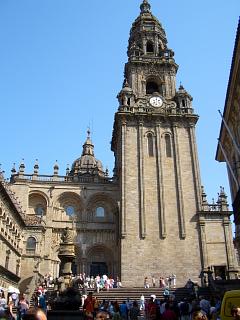 collectors ensure that it is always spotless making you question if you are in a real city, or simply a themed world created by the likes of Disney.
collectors ensure that it is always spotless making you question if you are in a real city, or simply a themed world created by the likes of Disney.
You can enter the historic area of Santiago from any direction and simply following the other tourists will take you into the heart of the city. Parking up by car is however problematic as Santiago is famed for its grid-locked traffic jams. Bearing this in mind you need to arrive early, or be prepared to park up at the first parking lot you see that displays a "spaces available" sign. Unfortunately this may be up to a mile from the center of the old district, but trying to get closer will invariably result in a good hour stuck in heavy traffic jams. Taxis or busses are the alternative. Right, a clock tower in the split level plaza known as the silversmiths (platerias) square.
Not surprisingly the cathedral's twin towers are visible from most routes that approach Santiago de Compostela, but on entering the medieval district on foot the towers and cathedral
temporarily disappear. The old town is built on top of something akin to a sloping plateau and once at this level you only catch glimpses of the cathedral's towers until you actually fall
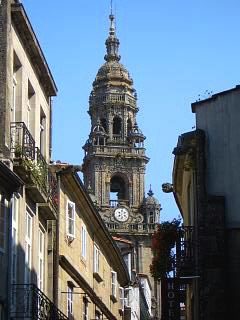 upon it.
upon it.
Unlike the monumental areas of Galicia's other major city's, Santiago has no decrepit buildings, no tacky bars and nothing at all that seems out of keeping with the history and architecture of the city. Virtually all of the old town's streets are pedestrianized and many are cobbled or flagged. The pervading tone of the area is the light grey to brown of the region's traditional granite, although red terra cotta roof tiles add some additional dashes of bright color. There are also plenty of galeria style (glass enclosed) balconies suspended above the streets, many of which help add a colonnaded feel to the lanes in which they are found.
Wondering down any street in Santiago has you looking up and down at the display of magnificent facades that surround you and all the tapas bars and memento shops that you could ask for are present and waiting for your custom. Tourist information is also easily obtained. There are several high street information points along with kiosks that have guides, maps and bilingual advisers. Getting information in Santiago is easy.
Deciding how to explore Santiago de Compostela is a matter of choice. Most visitors head straight for the cathedral and then, having had a good look around, radiate way from it to the
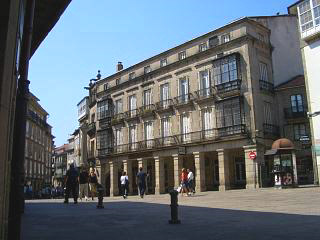 plazas and buildings littered about its circumference. Taking the reverse approach works just as well, but a factor to consider is the cathedrals lunch time closure from 2.00pm to 4.00pm. This is particularly important if you want to purchase the cathedral's "all areas" pass which can easily extend your visit by over two hours.
plazas and buildings littered about its circumference. Taking the reverse approach works just as well, but a factor to consider is the cathedrals lunch time closure from 2.00pm to 4.00pm. This is particularly important if you want to purchase the cathedral's "all areas" pass which can easily extend your visit by over two hours.
Exactly what to look at is the second tourist challenge in Santiago, there is a lot to see and you need a genuine two days to do the city and all of its sites justice. If time is limited, then the cathedral along with the buildings in and around its four surrounding squares should be at the top of the list. These squares are called the Obradoiro, the Quintana, the Azabacheria and the Platerias and most of Santiago's major monuments can be found in or very close to at least one of them. That said there are many more, an example of which can be seen above.
Below, the complex baroque stone work of the cathedral at high level.
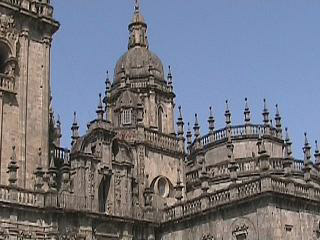 Although having a good look at the buildings of Santiago's architectural legacy is a must, simply wondering about the old town without a plan or itinerary is every bit as worthwhile. Most of the streets and alleys are fairly level, although there are some slopes beyond the cathedral area that are slightly more taxing. For those who get tired or simply want a break there are plenty of bars and cafes lying in wait. If you want to eat Santiago it can be expensive, but frequently walking just a hundred of so yards outside the main tourist hub will see prices fall. One other thing, an outside table will add a supplement of up to 15% to your bill. This is not a "con", but simply a covering charge for the fee these establishments pay to the authorities in order to use the plazas and courtyards as dining areas.
Although having a good look at the buildings of Santiago's architectural legacy is a must, simply wondering about the old town without a plan or itinerary is every bit as worthwhile. Most of the streets and alleys are fairly level, although there are some slopes beyond the cathedral area that are slightly more taxing. For those who get tired or simply want a break there are plenty of bars and cafes lying in wait. If you want to eat Santiago it can be expensive, but frequently walking just a hundred of so yards outside the main tourist hub will see prices fall. One other thing, an outside table will add a supplement of up to 15% to your bill. This is not a "con", but simply a covering charge for the fee these establishments pay to the authorities in order to use the plazas and courtyards as dining areas.
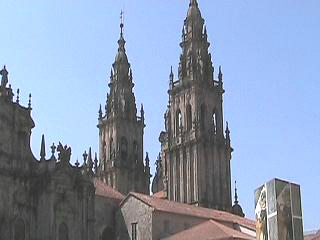
To find out more about the cathedral and other sightseeing attractions of this city, select from the various menu buttons to the right. Above, what for many is the first view they get of Santiago's elegant cathedral towers.
Back to the home page of the Santiago guide.

